Chapter 4 "Lath"
Lath is a material that supports and reinforces plaster, and cement plaster (stucco).
Lath is pronounced with a short "a": ˈlath.
How to pronounce lath
Lath is not lathe, with an e on the end, pronounced
with a long "a": lāt͟h. A lathe is a machine that rotates a stock to shape a round object and is used in making furniture, guns, etc.,
and turning brake drums and rotors, etc. I hear lath called lathe frequently, and even see the word lathe on plans to jobs.
This drives me crazy to hear or see lathe instead of lath.
There are several kinds of metal lath. Wood lath was used in the old days. Wood lath are strips of wood nailed to the framing lumber. A space was left in between each strip to allow mortar to squish through, holding the plaster in place. Gypsum lath are sheets of gypsum board, like sheetrock. Gypsum lath, or rock lath is made for interior use. Gypsum lath absorbs water rapidly and absorbs the mortar into the pores. This is called a suction bond. Click for more about suction bond.
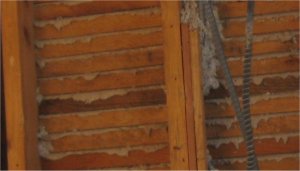
The mortar that squishes between the wood lath strip is called a "key". A reason for plaster failure on wood lath is broken keys.
You may have seen about wood wool board, used by plasterers from Wales. This wood strand lath is used for lime plaster. Click for more. There was a similar fiber board material used for lath in the 1940's. I saw it once on a bathroom ceiling in Arlington, VA that we replaced (that was falling apart). I saw this fiber board plaster base again in Silver Spring under exterior stucco that was falling apart. There was a sticker on the fiber board saying not for exterior use.
Another plaster base is blue board, or veneer plaster board. Veneer plaster is a thin application, so I don't think it is really lath. Other names are Imperial board (USG) or Cal core (National Gypsum). Other manufacturers include Certainteed, and others. The boards are the same as sheetrock, that is, gypsum board for drywall. The face paper is a little more porous for a good bond for the plaster and the sheets are color coded blue or greyish blue.
Wood lath for stucco was usually cut at angle, allowing mortar to key when there wasn't room for a good key. Click for more about wood lath for stucco. Wood lath is now obsolete, however broken keys and improper lath is a large source of stucco failure. Also, nearly all stucco on wood lath is just lime and sand, and not cement mortar. Lime and sand is weak and is damaged by water easily. You may have seen what I wrote about wood lath for stucco here.
Stucco, or plaster, applied to brick or block doesn't require lath, but lath sometimes is used for reinforcing inside or outside corners, and othe areas. Other substrates for plaster or stucco are terracotta blocks, which disappeared from the market about 1920, when the cinder block was invented, and gypblock, or gypsum blocks, which were made from cast molding plaster. Gypblock is now years obsolete. You may have seen gypblock non my website before.
There are several kinds of metal lath on the market today, and there has been many kinds over the years. The principle is the same: mortar squishes through and wraps around the lath which is what holds it on. Sadly, a lot of people just don't get it. When I get a call to estimate a job and someone tells me the carpenters or other inexperienced people put on the lath, I run, not walk away from that job.
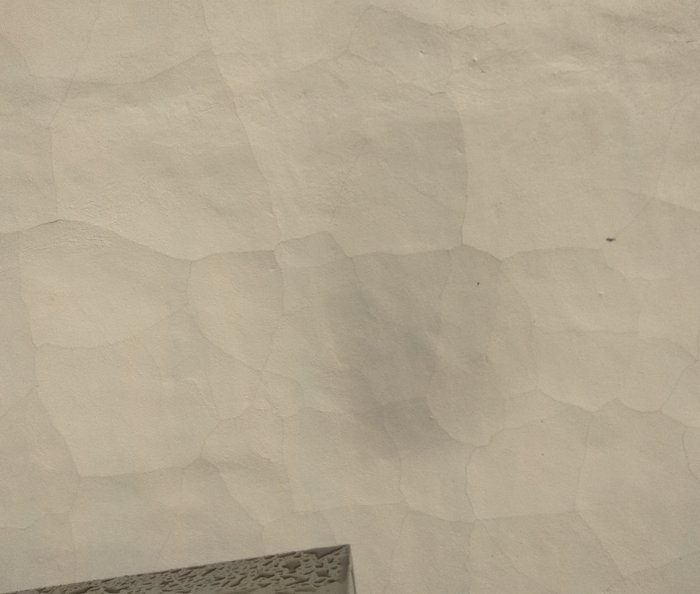
Raised cracks like this in stucco are mostly caused by metal lath too tight to the wall, not allowing mortar to key behind the lath. This metal lath and stucco application is from the 1970's.
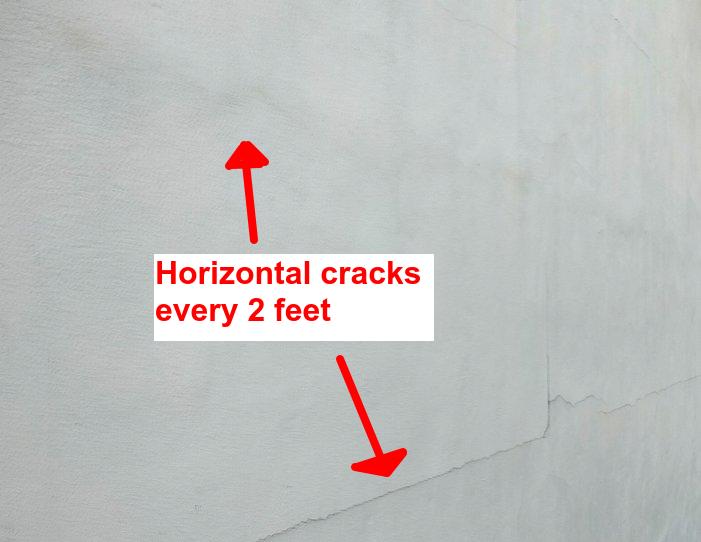
Horizontal cracks about 2 feet apart, along with vertical cracks about 8 feet apart are caused by the metal lath not being overlapped. Metal lath should be overlapped at least 1 inch.
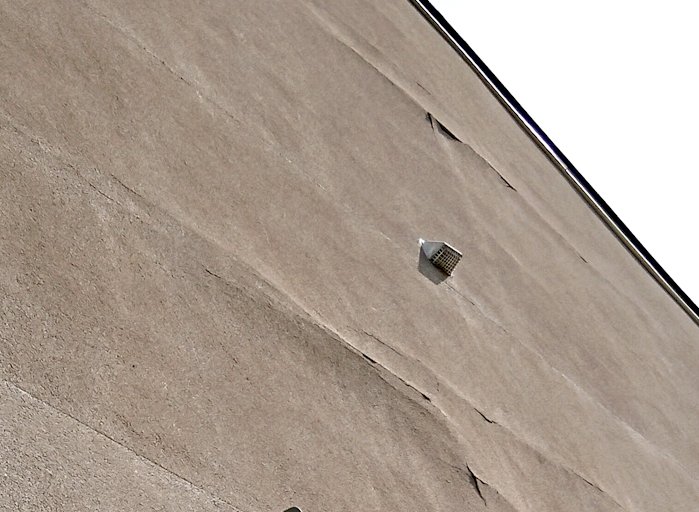
12 year old one coat stucco application is literally falling off the wall. Flat lath was used (not self furring).
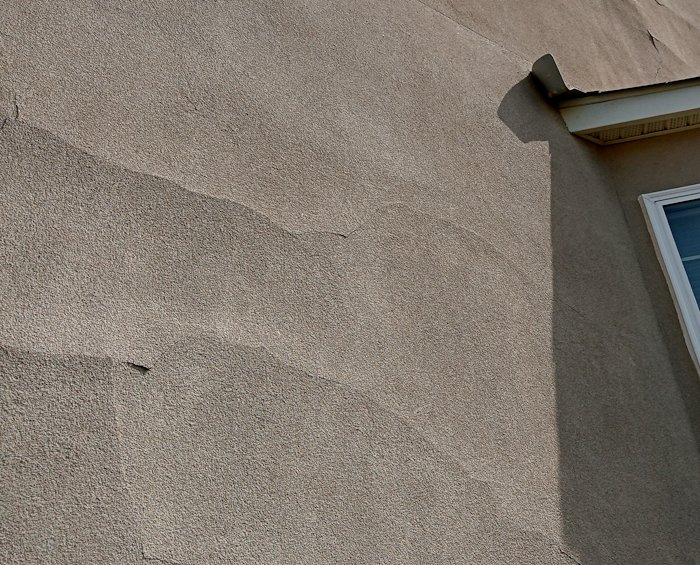
Same raised cracks as above, on worse. Stucco can be wiggled.
Plastic lath fails. You could wiggle the wall easily with one hand. Plastic lath is flat and mortar didn't key
There is nothing to hold this lath away from the wall. Not a drop of mortar keyed behind the lath. This kind of work is downright dangerous. There is plastic lath with quarter inch furring ribs behind it. I have only seen furring type plastic lath put on backwards, or upside down in the case of floors.
I am not going to bad mouth Ultra Lath. Ultra lath is a plastic lath made in Florida. Plastic lath works well in Florida because galvanized lath rusts quickly, due to the hot, humid climate. Ultra Lath has quarter inch ribs to hold the lath away from the wall for a good key. It seems like a good product. The only time I have seen Ultra lath used here in the Washington area the lath was put on backwards, or in the case of floors, upside down.
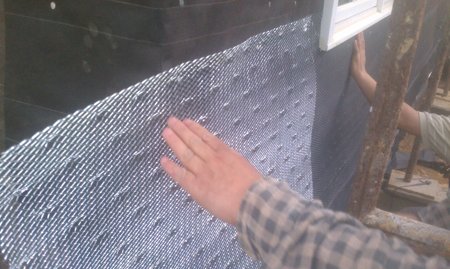
Self furring diamond mesh lath has dimples to hold the lath away from the wall for good mortar penetration.
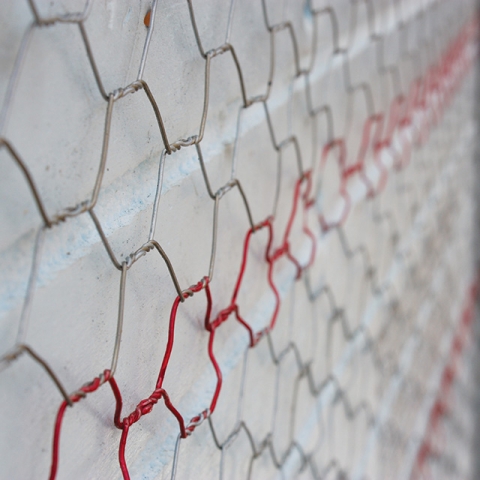
Western style stucco mesh has furring grooves to hold the lath away from the wall. The grooves are usually color coded red or yellow.
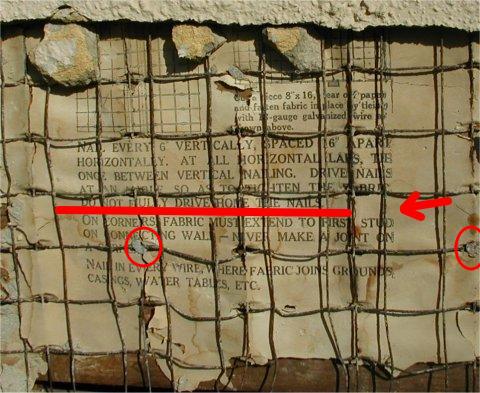
Idiots in 1924 didn't follow instructions. They drove the nails fully home, not allowing space for mortar to enter behind the welded wire lath. The only reason the mortar held on as long as it did are the few raised areas of the wire. Still, not following the manufacturers printed instructions leaves a poor quality product. Instead of a well bonded and well reinforced finished product, the mortar was just hanging in there.
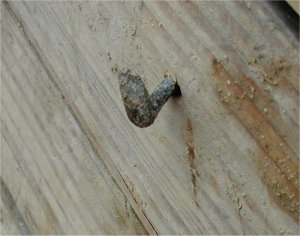
A furring nail from the 1920's on this house in Baltimore where we took off the welded wire lath. The head is off center allowing the wire to hook. The nail isn't driven in all the way allowing space for mortar behind the lath. Welded wire lath was really strong when it was put on right.
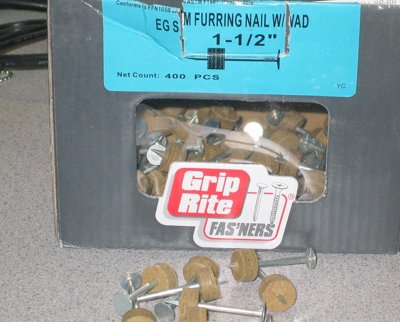
A furring nail from modern times are used out west on woven wire stucco mesh. The cardboard spacer is put between the lath and the wall.
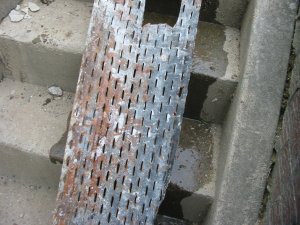
The first manufactured metal lath was called sheet lath. Sheet lath was sheet metal with holes punched. Sheet lath was used for plastering, and support for concrete floors. Sheet lath disappeared not long after 1900. Expanded metal lath came out about 1904.
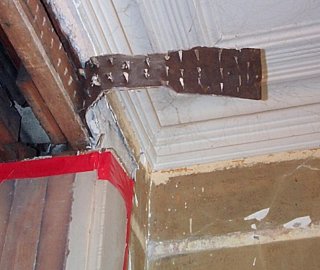
Home made metal lath that was made to support run in place plaster moldings. This was done about 1880. A piece of sheet metal was beat with a hatchet to make holes.
Apart from sheet lath, the three categories of metal lath are:
Expanded metal lath
Woven wire lath, or stucco mesh.
Welded wire lath.
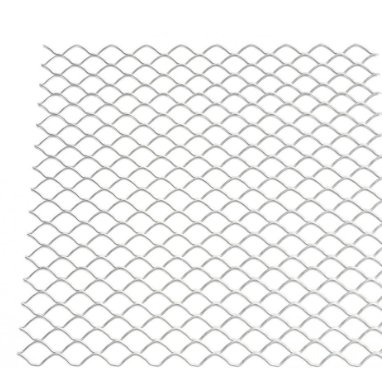
The three main categories of expanded metal lath are:
1. Diamond mesh (shown).
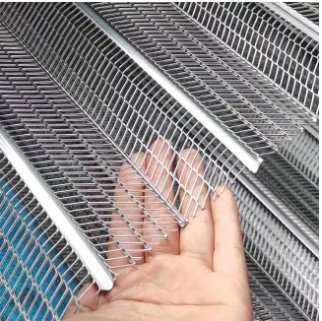
2. Flat rib lath
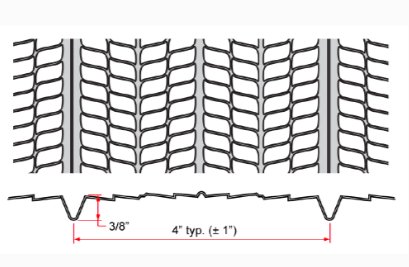
3. Hi Rib or 3/8" RIB lath
Expanded metal lath is made by cutting slits in a piece of sheet metal, and stretching, or expanding the metal. The expansion forms a mesh. Diamond mesh lath is made from a strip of sheet metal just over seven inches wide. The metal is stretched to about 27 inches wide. I have seen diamond mesh as narrow as 26 inches, and as wide as 29 inches. The width depended on how far the lath was stretched in the factory, and the brand. Manufacturers like Clark-Dietrich, have standardized the width to 27 inches. The length of a sheet is always 8 feet. Clark Dietrich lath is 8 foot 1 inch. I don't know if this is a promotion, or to give the customer an extra inch.
Diamond mesh lath comes in 2 weights: 2.5 and 3.4. What this means is that the lath weighs 2.5 pounds per square yard, or 3.4 pounds per square yard. 2.5 is fine for side walls, but 3.4 is a must for ceilings to prevent sag. In government work, 3.4 is usually specified for walls and ceilings. Years ago, when we did a lot of D.C. government work, the inspector would weigh the lath to make sure it weighed at least 3.4 pounds per yard. Lath is sold in bundles of ten sheets. Each bundle usually has a tag that says 2.5 or 3.4. There are reports that unscrupulous contractors use 2.5 and put on 3.4 tags.
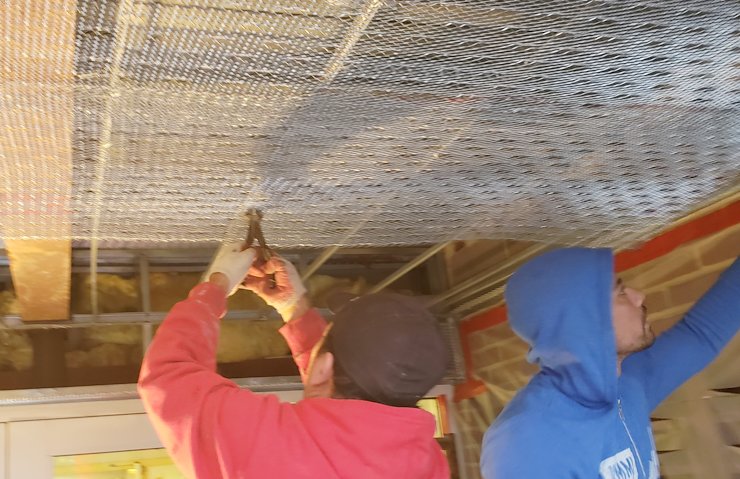
Self furring lath isn't necessary on channel iron ceilings. 3/4" channel iron allows mortar to key behind the lath. Why am I using self-furring lath here ? It is all I had. Self furring should be used on wood joists (or metal joists). This avoids a weak spot where the mortar doesn't key. Flat lath can be used on concrete re-bar and pencil rod. We used to do a lot of these ceilings years ago. They are dying out. Dollar for dollar, there is no better quality ceiling than a suspended plaster ceiling with channel iron framing.
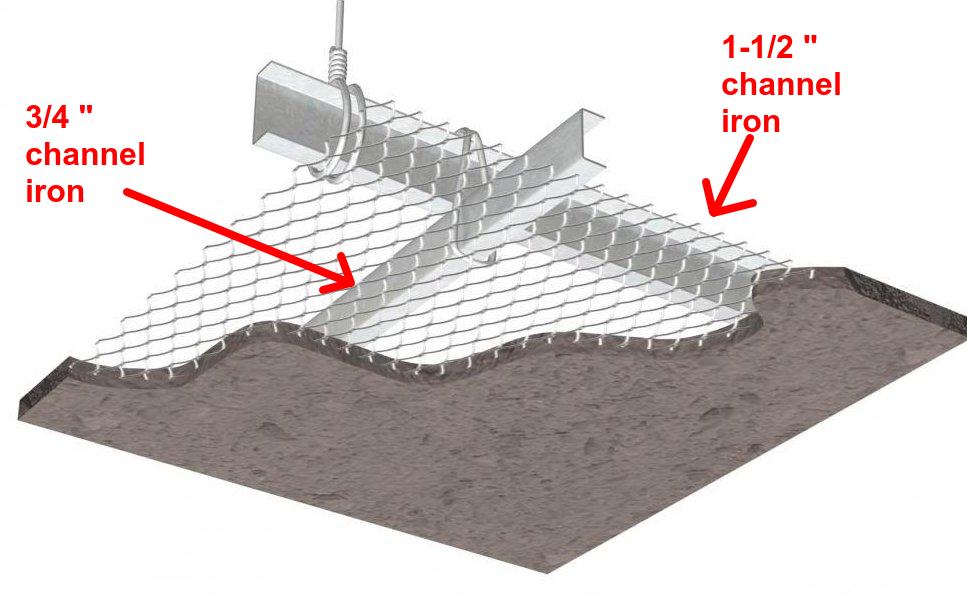
Another view of a suspended channel iron ceiling. Mortar from the scratch coat will wrap around the 3/4 iron, allowing the mortar to form a full key.
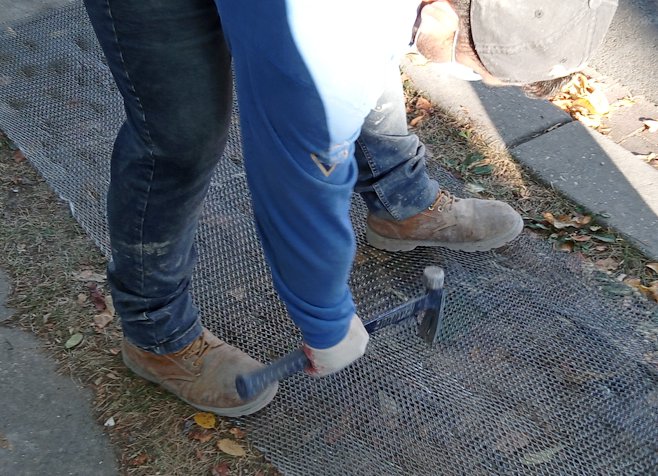
If self furring lath isn't available, flat lath can be beaten with a hammer to form dimples.
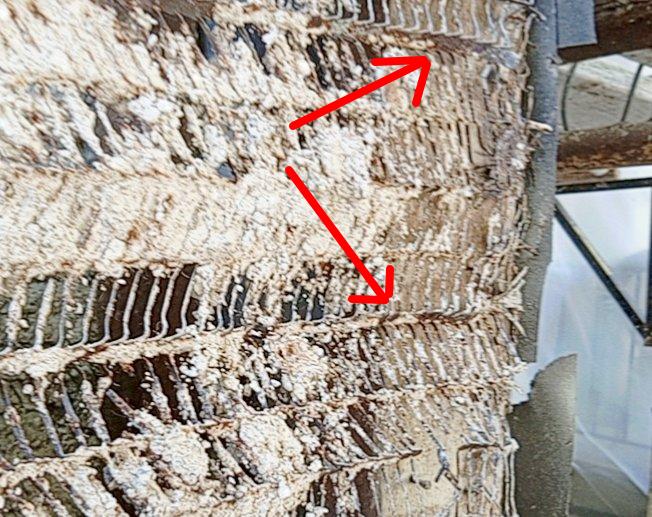
Flat rib lath is self furring. Every fourth rib is higher than the others. The point of the V needs to be pointed into the stud, or wall. Lath put on backwards can fail. This lath was put on right in 1909.
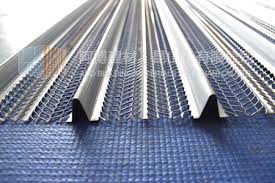
High rib lath, Hi rib or 3/8" rib lath has a high rib about every 4 inches. The rib every four inches provides a good solid overlap. Many years ago, I worked on a lathing crew for a big company, learning the trade. We used hi rib on ceilings for interior plaster in schools and hospitals, and used 3/4 diamond mesh for stucco. I prefer to use diamond mesh for everything.
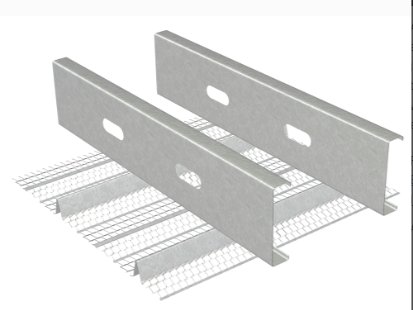
I have something important to say here.
Note how in the picture the point of the lath is up. This allows mortar to key between the lath and the joist, whether a wood joist, or a metal joist like pictured with a 1-1/2" nailing web. On channel iron ceilings, hi rib must be put on upside down, that is with the open V up. You can probably see why without an explanation.
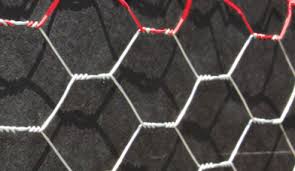
Woven wire lath, known as stucco mesh, is an excellent reinforcement for stucco. I would use stucco mesh if I could find someone to ship it to me. This is sold in rolls, self furring and flat, paper backed and not paper backed. The people who make this and sell it find it offensive when someone calls this chicken wire. In fact, the people who sell poultry netting find it offensive when poultry netting is called chicken wire. It is fascinating to see how this is made. Here is a link to Hexagonal Wire Mesh Weave Machine.
Welded wire lath is still made. We find it in old houses built in the 1920's. It is used mainly for high abuse walls and for security.
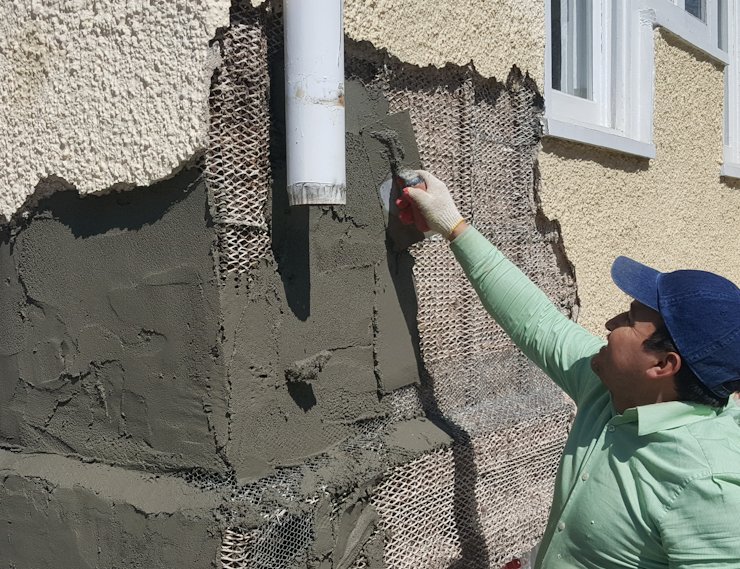
This diamond mesh lath put on in 1910 is still in excellent shape
A large source of our work is stucco failure caused by interior lath used outdoors. It is usually identified by a old house that has a lot of patches, even most of the old houses in neighborhood are in good shape. We work for customers that call us every so many years when another loose area appears. Loose or rotted lath is characterized by "bubbles" in the wall ar appearance thae wall is pregnant. There are other reasons for stucco failure like water damage, etc., but lath failure is easy to spot when the wall has bubbled.
They quit making interior lath years ago and only make galvanized lath. Interior lath was called painted lath, but the paint was really a cheap black coating. Of course interior lath was cheaper. I have seen interior lath over used over the years for outside stucco. Building I noticed being lathed in the 1980's with painted lath are already falling apart.
Please don't call expanded metal lath "wire" !
Plasterers call metal lath, "metal lath". Wire is a round length of metal. There are many kinds of wire used in and around plastering. For example : hanger wire, tie wire, guide wires, line wires, electric wires, etc.
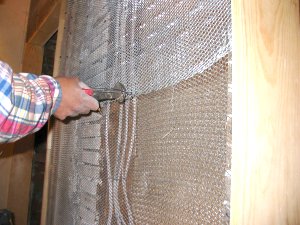
Tying the laps. When there is no sheathing to nail to it is important to tie the "laps", that is the part of the lath that overlaps in between the studs. I always do two ties on each lap. This is also important over sheathing you can't nail to. For example: Dens-glas or other gypsum sheathing, therma-ply (glorified cardboard), celotex, etc.
Line wires work well to support the lath when there is no sheathing. The idea is to support the lath until the scratch coat sets up. For more information about line wires, check out this info from the Stucco Manufacturers Association:
Thanks for reading this. I hope someone will read this and I can make an impact somewhere.